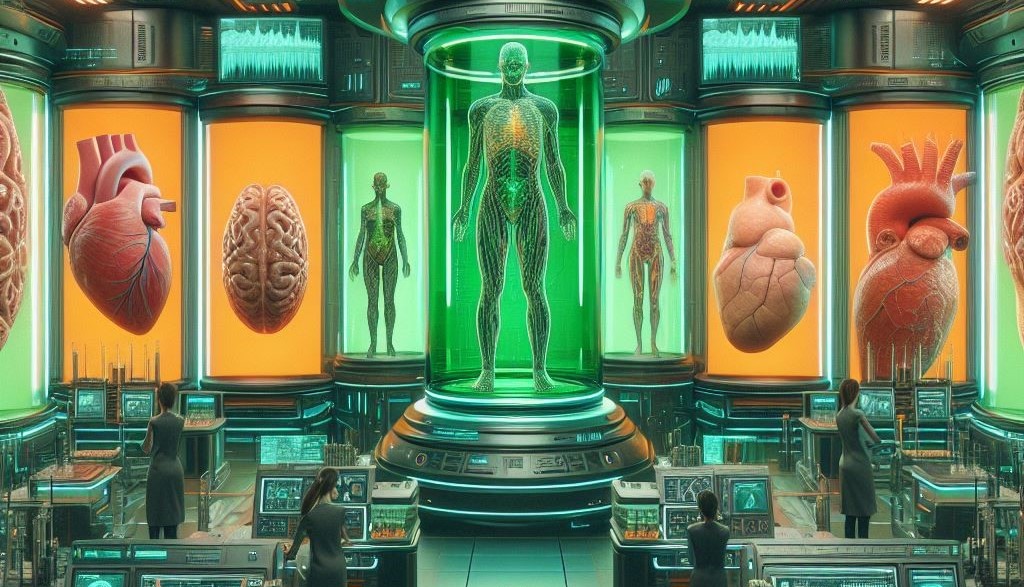
Hey Doc, I need an upgrade

Longevity is attainable from human ‘spare part’ factories
- Dateline
- 3 May 2036
Wheng Fei ran his finger down the list of markers on the small slip. Blood pressure’s okay, blood glucose’s good, oxygenation’s okay, liver function’s acceptable, kidneys… hmmm that could need a bit of help… He pulled up the Lotus BioMed app on his phone, shared the blood analysis data, and waited. The app beeped and he scrolled through the options on offer: A lab-grown kidney with four years warranty (given his current lifestyle), or a 3D printed synthetic version promising another 40 years. He clicked on the synthetic option and selected one of the timeslots available for next week Thursday, just after the re-surfacing of his knee joints. He accepted the calendar request and approved the payment through a facial scan.
The elective kidney procedure completed his allocated quarterly upgrade program, which was a major part of his accepting this new job. Wheng flicked the half-finished cigarette into the gutter and headed back into the bar to join his new colleagues.
Lotus BioMed’s advances in 3D organ and tissue printing had catapulted them into stardom in the late 2020s, allowing for rapid acquisitions of ancillary biotech companies. They could now offer a full suite of printed and grown organs, bio-mechanical joints and bones, carbon fiber enhanced muscle tissues, and were working on an advanced memory back-up product that would help them open up a new business segment.
China’s more flexible regulatory environment had enabled local companies to become world leaders in elective bio-enhancements, and the private medical suites around Shanghai saw millions of wealthy customers flocking in each year. The industry has capitalized on a perfect storm of events: Self driving cars have almost eliminated fatal traffic accidents worldwide, which in turn strangled the supply of organ donors. The fast emergence of black-market organs by criminal syndicates was quickly squashed by AI driven policing systems, leaving the approval for private organ growing and printing the only viable option. Once the demand from medically related needs was fulfilled, the industry looked for new markets.
Wheng Fei is one of the new breed of customers, belonging to the rich elite that opt for elective organ replacements and bio-enhancements to boost their energy, performance, and longevity. 3D printing of synthetic organs allows for quick swap outs to counteract any wear and tear, diminishing performance, or for new models with enhanced features.
With this new technology, designer organs are cheap and abundant. Gone are the days when you could wait years for a donated organ. Now they are available on demand.
Why does this matter?
Research labs are busy developing synthetic 3D printing and growing of organs and it is just a question of time before they receive regulatory approval and become commercially (and technically) available. But what the scenario above really shows is that opportunities lie in the intersection of industries and that by thinking of 2nd and 3rd order implications, we can unlock hidden opportunities created by seemingly disconnected events.
Links to related stories
- The decades-long quest for lab-grown organs – Popular Science, 4 Mar 2024
- Artificial Organs: Innovating to Replace Donors and Dialysis – The Scientist, 20 January 2023
- Meet the technologist printing a cure to diabetes – Quartz, 18 December 2023
- Mindbullet: Printing the Philosopher’s Stone (Dateline: 9 August 2029)
- Mindbullet: Forget me not with nanotech (Dateline: 27 May 2033)
Warning: Hazardous thinking at work
Despite appearances to the contrary, Futureworld cannot and does not predict the future. Our Mindbullets scenarios are fictitious and designed purely to explore possible futures, challenge and stimulate strategic thinking. Use these at your own risk. Any reference to actual people, entities or events is entirely allegorical. Copyright Futureworld International Limited. Reproduction or distribution permitted only with recognition of Copyright and the inclusion of this disclaimer.